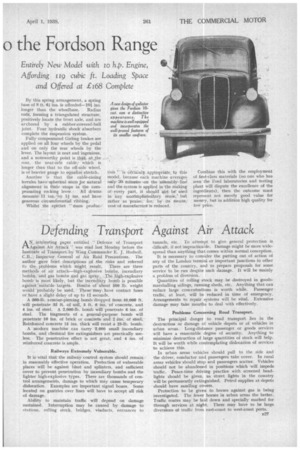Defending Transport Agatnst Air Attack
Page 41

If you've noticed an error in this article please click here to report it so we can fix it.
Aiiiterpsting paper entitled " Defence of Transport Against Air Attack " was read last Monday before the Institute of Transport by Wing Commander E. J. alodsoll, C.B., Inspector, General of Ail Raid Precautions. The author gave briefdescriptions of the risks and referred to the problems which might. :result, There are three methods of air attack—high-explosive boinbs, incendiary bombs, and gas bombs 4nd gas spray.. The ,high-explosive bomb is most likely, but the Sincenclikry -bomb is possible againsts'suitabIetargets. Bombs of about 500 lb. weight would probably be used. These may.. have contact fuses or have a slight delay of up to 12 seconds.
A 500-1b. armour-piercing bomb dropped from -11);000 ft. will penetrate 35 ft. of soil, 5 ft. 6-ins. of concrete, and 4 ins, of steel. A 2,000-lb. bomb will penetrate 6 ins, of steel. The fragments of a general-purpose bomb will penetrate 10 ins, of brick or concrete and 2 ins, of steel. Reinforced concrete 15 ins, thick will resist a 25-lb. bomb.
A modern 'machine can carry 2,000 small incendiary bombs, and chemical fire extinguishers are practically useless. The penetrative effect is not great, and 4 ins. of reinforced concrete is ample.
Railways Extremely Vulnerable. "
It is vital that the railway control system 'should remain in reasonably effective operation. Protection of vulnerable places will be against blast and splinters, and sufficient cover to prevent penetration by incendiary bombs and the lighter high-explosive types. There are thousands of control arrangements, damage to which may cause temporary dislocation. Examples are important signal boxes. Some located on gantries over lines will have to accept all risk of damage.
Ability to maintain traffic will depend on damage sustained. Interruption may be caused by damage to stations, rolling stock, bridges. viaducts, entrances to tunnels, etc.. To attempt to give general protection is difficult, if not impracticable. Damage might be more widespread than anything that comes within normal conception. It is necessary to consider the putting out of action of any of the London termini or important junctions in other parts of the country, and to prepare proposals for some service to be run despite such damage. It will be mainly a problem of diversion. Quantities of rolling stock may be destroyed in goodsmarshalling sidings, running sheds, etc. Anything that can reduce large concentrations is worth while. Passenger traffic, at least, will be reduced in time of emergency. Arrangements to repair systems wilt be vital. Extensive damage may take months to deal with effectively.
Problems Concerning Road Transport.
The principal danger to road transport lies in the destruction or damage of vehicle depots or of vehicles in urban areas. Long-distance passenger or goods services will have a reasonable degree of security. Anything to minimize destruction of large quantities of stock will help. It will be worth while contemplating dislocation of services to achieve this.
In urban areas vehicles should pull to the , side and the driver, conductor and passengers take cover. In rural areas vehicles should stop and passengers scatter. Vehicles should not be abandoned in positions which will impede traffic. Peace-time driving practice with screened headlights should be given, as street lights in the country will be permanently extinguished. Petrol supplies at depots should have sandbag covers,
Protection to be given to horses against gas is being investigated. The fewer horses in urban areas the better. Traffic routes may be laid down and specially marked for through services at night. There may have to be large diversions at traffic from east-coast to west-coast ports,




























































































